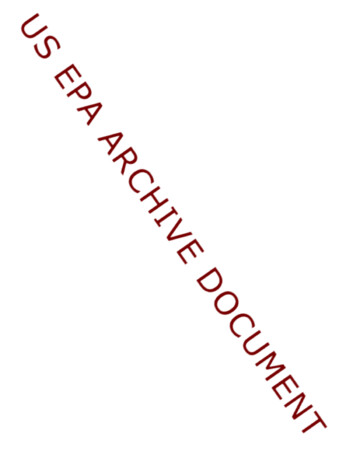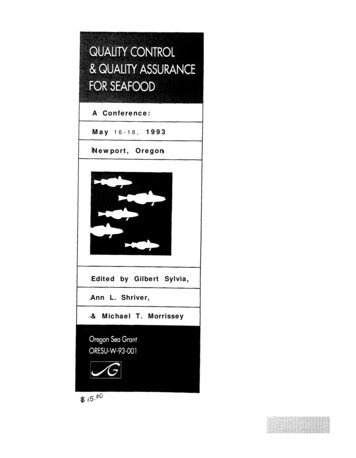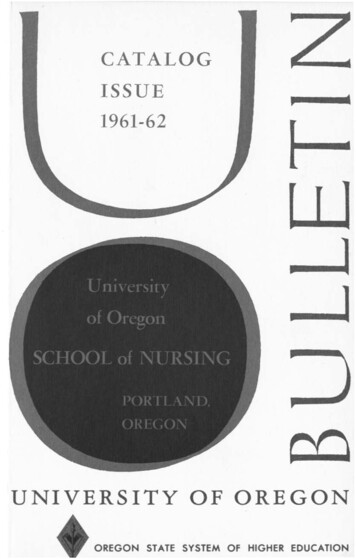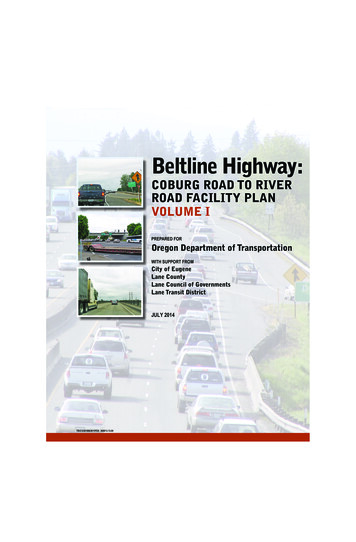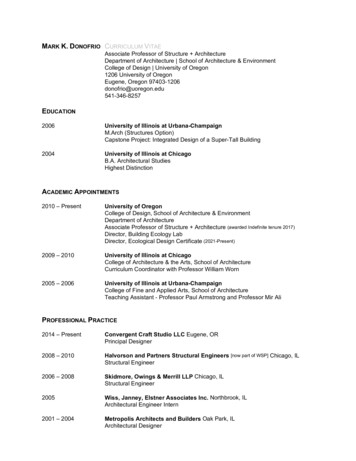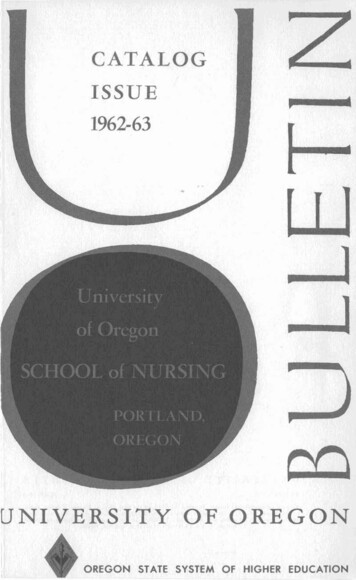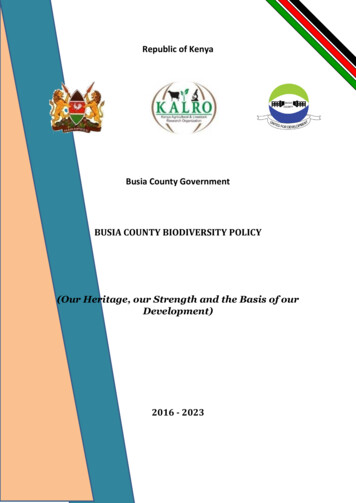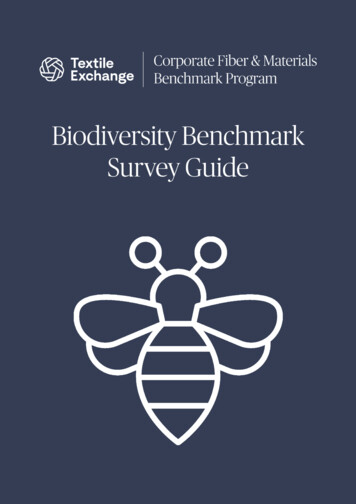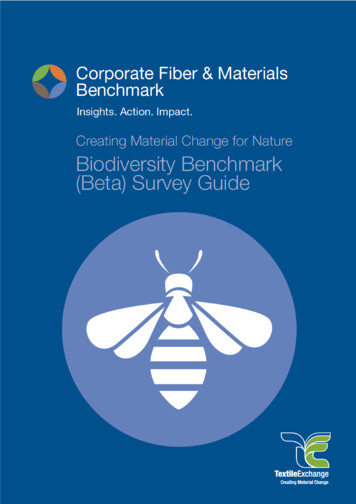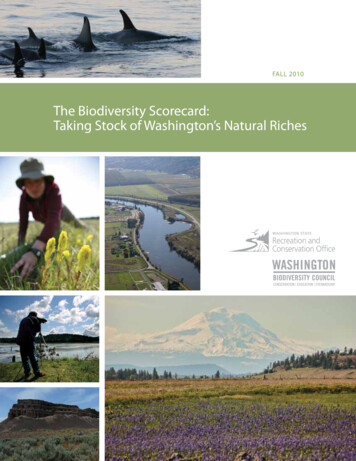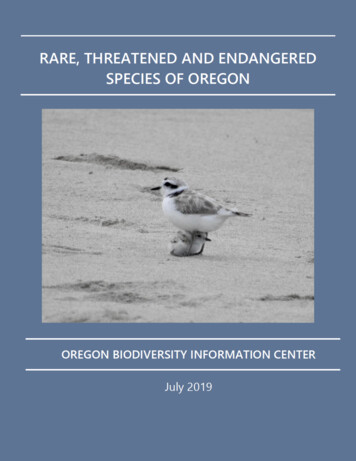
Transcription
Oregon Biodiversity Information CenterInstitute for Natural ResourcesPortland State UniversityP.O. Box 751, Mail Stop: INRPortland, OR 97207-0751(503) 725-9950http://inr.oregonstate.edu/orbicWith assistance from:U.S. Forest ServiceBureau of Land ManagementU.S. Fish and Wildlife ServiceNatureServeOregonFlora at Oregon State UniversityThe Nature ConservancyOregon Parks and Recreation DepartmentOregon Department of State LandsOregon Department of Fish and WildlifeOregon Department of AgricultureNative Plant Society of OregonCompiled and published by the following staff at the Oregon Biodiversity Information Center:Jimmy Kagan, Director/EcologistSue Vrilakas, Botanist/Data ManagerEleanor Gaines, ZoologistLindsey Wise, Botanist/Data ManagerMichael Russell, Botanist/EcologistCayla Sigrah, GIS and Database Support SpecialistCover Photo: Charadrius nivosus (Snowy plover chick and adult). Photo by Cathy Tronquet.ORBIC Street Address: Portland State University, Science and Education Center,2112 SW Fifth Ave., Suite 140, Portland, Oregon, 97201ORBIC Mailing Address: Portland State University, Mail Stop: INR, P.O. Box 751, Portland, Oregon 97207-0751Bibliographic reference to this publication should read:Oregon Biodiversity Information Center. 2019. Rare, Threatened and Endangered Species of Oregon. Institute for NaturalResources, Portland State University, Portland, Oregon. 133 pp.
CONTENTSIntroduction .1Distribution Information .3Oregon Map with Ecoregions and Counties .4Definitions .5Special Animals.7Summary List . 10Fish. 10Amphibians . 13Reptiles . 14Birds. 15Mammals . 20Invertebrates. 24Animals Arranged by Status .37Federal Endangered Species Act Status .37Federal Species of Concern . 38State Endangered Species Act Status. 39ODFW Sensitive Species . 40ODFW Conservation Strategy Species 43Drops and Name Changes. 47Special Plants . 48Summary List . 52Vascular Plants. 52Marine Algae .97Liverworts and Hornworts . 98Mosses. 101Lichens.106Fungi . 110Plants Arranged by Status .124Federal Endangered Species Act Status .124USFWS Species of Concern .124State Endangered Species Act Status .125Drops and Name Changes.127Plant Field Survey Form .130Animal Field Survey Form . 131Acknowledgments .132Codes and Abbreviations .133
INTRODUCTIONToday, plant and animal species are disappearingworld-wide at an accelerated pace. Based on currenttrends, many scientists believe that over half of thespecies present on earth in 1900 will be extinct by2100. The major causes are climate change,introduced invasive species, and continued habitatloss from increasing water, housing, food, fiber, woodand energy needs. In spite of increased conservationfunding and work, all of these threats to theenvironment continue to increase, in Oregon andthroughout the world.Once lost, a species can never be recovered, andthere is no way of knowing how useful it may havebeen. We do know that human beings and many oftheir industries depend on plant and animal products.About 50% of all pharmaceuticals have a naturalcomponent as an active ingredient, yet less than onepercent of the world's species have been chemicallyanalyzed and tested. Many insects and plants containundescribed and highly functional compounds.Limnanthes pumila ssp. grandiflora, or big-floweredwoolly meadowfoam, a rare plant that grows insouthwest Oregon, has been found to produce ahybrid with the more common member of the genus,Limnanthes alba. This hybrid grows well in the poorlydrained soils of the Willamette Valley and produces avaluable oil used for soaps, plastic and rubberproduction. In addition, the hybrid meadowfoamdoes not require the field burning necessary for othercrops. This species is very rare, and like many otherOregon natives, will be lost without intervention.Maintaining as much diversity as is possible isespecially important to maintain the possibility ofcontinued evolution in light of the dramatic changesto the climate and to ecosystems structure andcomposition currently underway. Regardless ofspecies immediate value, the diversity of life is a majorsource of wonder and enjoyment for many people,and maintaining them is a responsibility Oregonianshave for their children and future Oregonians. Thepurpose of this publication is to integrate and analyzeall of the available information on the status andtrends of the rare and at-risk flora and fauna ofOregon, and provide it to land owners and managers,decision-makers, owners and interested parties.Oregon State Endangered Species ProgramsIn 1987, the Oregon Legislature passed anEndangered Species Act which gave the OregonDepartment of Agriculture (ODA) responsibility andjurisdiction over threatened and endangered plants,and reaffirmed the Oregon Department of Fish andWildlife's (ODFW) responsibility for threatened andendangered fish and wildlife. Both of these agencieshave entered into cooperative (Section 6) agreementswith the United States Fish and Wildlife Service(USFWS) for the purpose of carrying out research andconservation programs for animals and plants underthe auspices of the federal Endangered Species Act.Oregon Parks and Recreation Department (OPRD) hasa similar agreement with USFWS for invertebrates.More information on the state endangered speciesprograms can be found at the beginning of theanimal and plant sections of this book.Oregon Biodiversity Information CenterThe Oregon Biodiversity Information Center (ORBIC)is part of the Institute for Natural Resources (INR)located at Portland State University (PSU). ORBICmaintains extensive databases of Oregon biodiversity,concentrating on rare and endangered plants,animals and ecosystems. Since its creation in 1979 asthe Oregon Natural Heritage Program, ORBIC hasbeen part of the Natural Heritage network. ORBIC is aconstituent member of NatureServe, a non-profitorganization with a mission to provide the scientificbasis for effective conservation action. NatureServeand Oregon manage data using standards andprotocols used across the U.S., Canada, and much ofLatin America.ORBIC has a primary mission to track thedistribution and status of all of Oregon’s flora andfauna, including all vertebrates and vascular plants,and as many invertebrates, fungi, and lichens as ispossible. For species considered to be at-risk inOregon or across the planet, location and populationdata is managed for all of the observations andoccurrences in the state. These data, and theknowledge of the many professional and amateurbiologists across the state, provide the basis of thestatus information in this book.ORBIC is managed by PSU, but has been a1
cooperative program with significant support,funding, and assistance from Oregon State University,The Nature Conservancy in Oregon, the Bureau ofLand Management (BLM), the U.S. Forest Service(USFS), the Department of State Lands, USFWS,OPRD, and ODFW. The Interagency SpecialStatus/Sensitive Species Program of the US ForestService Region 6 and Oregon/Washington BLM hasprovided funding, support, collaboration, andexpertise with rare species in our region.Biologists working for these agencies, together withthe state's herbaria and museums, provide most ofthe information that comprise ORBIC's databases.ORBIC also manages the state Natural Areas Programwith OPRD. More can be learned about the NaturalArea Program from the Oregon Natural Areas ate.edu/files/2015 or natural areas plan.pdf. In addition toNatural Areas and at-risk species, ORBIC manages theSection 6 invertebrate program for OPRD, and tracksinvasive species sites and management through theOregon iMapInvasives ces/, andthe Oregon Invasive Species Hotline,https://oregoninvasiveshotline.org/.This book has been compiled using the mostcurrent information available on the distribution andabundance of plants and animals native to Oregon.Taxonomic experts who were consulted for thisedition are listed in the Acknowledgments section.Although based on a large volume of information, it isby no means complete. Much is known about somespecies, and very little about others. ORBIC welcomesadditional information or recommendations regardingany of the taxa listed herein. Such information, as wellas data requests, should be directed to:Oregon Biodiversity Information CenterInstitute for Natural ResourcesPortland State UniversityMail Stop: INRPO Box 751Portland, Oregon 97207-0751Or send an email to inrdata@pdx.edu. Online versionsof this book are at http://inr.oregonstate.edu/orbic.2OutlineThis book is divided into animal and plant (includinglichen and fungi) sections. The sections begin with adescription of the animal and plant programs in thestate and are followed by the main list of animals andplants.For animals, the list is first divided into major groups(fish, amphibians, reptiles, mammals, birds, andinvertebrates) and then arranged alphabetically byscientific name. Invertebrates are further divided byclass and order. The plant list is first divided into fourgroups (vascular plants, non-vascular plants, lichensand fungi) and then alphabetized by scientific name.The information for each taxa includes: the scientificand common names with authorities for plants;county, ecoregion, and adjacent state distributioninformation; the state and federal status; theNatureServe/Heritage Network Global and Stateranks; and the ORBIC list number.Criteria and DefinitionsInclusion of any given taxon on these lists is basedon several specific criteria. The most important factorsare the total number of known, extant populations inOregon and world-wide, and the degree to whichthey are potentially or actively threatened withdestruction. Other criteria include the number ofknown populations considered to be securelyprotected, the size of the various populations, and theability of the taxon to persist at known sites.The taxonomic distinctness of each species also hasbeen considered. Hybrids and questionable orundescribed species have not been included,although undescribed taxa that are recognized by thescientific community in Oregon are included,particularly for fish and invertebrates. These criteriaare also used in development of NatureServe/NaturalHeritage Network species ranks.Definitions and explanations of the various ranksand federal and state statuses are provided in theDefinitions section and summarized on the backinside cover along with a list of abbreviations. Anumber of definitions and criteria specific to animals(e.g., wintering or breeding ranks in birds) arediscussed in detail at the beginning of the animalsection of this book. Further resources are availablefrom ing-systems.
DISTRIBUTION INFORMATIONDistribution InformationCountiesThe distribution information included on the listsrepresents both the current and historic, documenteddistribution of the taxa.Distributions for each taxa are listed in thesummary species lists in the following format:Ecoregions; States (and/or Canadian Provinces); andCounties. Out-of-state distribution information iscomplete for plant and animal taxa on ORBIC List 1(which are usually Oregon or regional endemics). Forall other taxa, all adjacent states or the closest statewith occurrences will be listed; a plus sign ( ) signifiesthat the taxa is found in additional states. Taxa withno other states noted are Oregon endemics. For themost part, the Ecoregion, County and Statedistribution is based on both historic and currentinformation. Any additional input on distribution willbe incorporated in future updates of this publication.Oregon has thirty-six counties. The abbreviationsused in the book are made from the first four lettersof each county name. The county names are: Baker,Benton, Clackamas, Clatsop, Columbia, Coos, Crook,Curry, Deschutes, Douglas, Gilliam, Grant, Harney,Hood River, Jackson, Jefferson, Josephine, Klamath,Lake, Lane, Lincoln, Linn, Malheur, Marion, Morrow,Multnomah, Polk, Sherman, Tillamook, Umatilla,Union, Wallowa, Wasco, Washington, Wheeler, andYamhill. The county information included is based ondata in the ORBIC database. Please notify us ofmistakes or omissions.EcoregionsORBIC divides the state into nine distinct regionsbased on geologic and vegetative patterns. The mapand the regions are based on the EnvironmentalProtection Agency’s Level 3 ecoregions. TheEcoregions are: BM Blue Mountains, BR NorthernBasin and Range, CB Columbia Basin, CR CoastRange, EC East Cascade Range, KM KlamathMountains, ME Marine and Estuarine, WC WestCascade Range and Crest, and WV WillametteValley.States and Canadian Provinces andTerritoriesState, provincial, and territorial distribution isincluded on the lists primarily to alert biologists tothe distribution of these rare, threatened, andendangered taxa in adjacent states. The distributionfor the more wide ranging species in states notadjacent to Oregon is based on publishedinformation and may not be complete. Two-letterpostal abbreviations are used to identify theseregions. States adjacent to Oregon are:CA California, ID Idaho, NV Nevada, and WA Washington. Other state and province abbreviationscan be found in the "Codes and Abbreviations"section.3
OREGON MAP WITH ECOREGIONS AND COUNTIES4
DEFINITIONSEndangered. Taxa which are in danger of becomingextinct within the foreseeable future throughout allor a significant portion of their range.Threatened. Taxa which are likely to becomeendangered within the foreseeable future.LE Listed Endangered. Taxa listed by the USFWSor the National Marine Fisheries Service (NOAAFisheries) as Endangered under the EndangeredSpecies Act (ESA), or by the ODA or ODFW underthe Oregon Endangered Species Act of 1987(OESA).LT Listed Threatened. Taxa listed by the USFWS,NOAA Fisheries, ODA, or ODFW as Threatened.PE Proposed Endangered. Taxa proposed by theUSFWS or NOAA Fisheries to be listed asEndangered under the ESA or by ODFW or ODAunder the OESA.PT Proposed Threatened. Taxa proposed by theUSFWS or NOAA Fisheries to be listed asThreatened under the ESA or by ODFW or ODAunder the OESA.C Candidate. Taxa for which NOAA Fisheries orUSFWS have sufficient information to support aproposal to list under the ESA, or which is acandidate for listing by the ODA under the OESA.SOC Species of Concern. Species of Concern is aninformal term that commonly refers to thosespecies which the USFWS believes might bedeclining or in need of conservation actions. Theterm Species of Concern is not defined in the ESA,receive no legal protection and the use of the termdoes not necessarily mean that the species willeventually be proposed for listing as a threatenedor endangered species.PS Partial Status. Taxa for which some but not allpopulations have status.Agency Status ListsIn addition to the main lists summarizinginformation on animals and plants, this book includesthe agency lists compiled from the most recentinformation available: Federal and State, listed and proposed animals(USFWS, NOAA Fisheries, ODFW) Federal candidate (USFWS, NOAA Fisheries) andspecies of concern (USFWS) animals State sensitive animals and Oregon ConservationStrategy species, including designated ecoregions(ODFW) Federal listed, proposed and candidate plants,and species of concern (USFWS) State listed and candidate plants (ODA)The criteria for the ORBIC lists are as follows:List 1: Threatened or Endangered ThroughoutRangecontains taxa that are threatened with extinction orpresumed to be extinct throughout their entirerange. Includes many rare Oregon endemic species.List 2: Threatened or Endangered in Oregon butSecure Elsewherecontains taxa that are threatened with extirpation orpresumed to be extirpated from the state ofOregon, but are secure or abundant elsewhere.These are often peripheral or disjunct species whichare of concern when considering species diversitywithin Oregon's borders. They can be verysignificant when protecting the genetic diversity of ataxon. ORBIC regards extreme rarity as a significantthreat and has included species which are very rarein Oregon but secure elsewhere on this list.List 3: Reviewcontains taxa for which more information is neededbefore status can be determined, but for whichthere is reason to believe they may be threatenedor endangered in Oregon or throughout theirrange.List 4: Watchcontains taxa which are of conservation concern butare not currently threatened or endangered. Thisincludes taxa which are very rare but are currentlysecure in Oregon, as well as taxa which aredeclining in numbers or habitat but are still toocommon to be proposed as threatened orendangered. While these taxa may not currentlyneed the same active management attention asthreatened or endangered taxa, they do requirecontinued monitoring.Drops and Name Changes contains taxa removedfrom the ORBIC lists or which have had their nameschanged from the previous edition.5
NatureServe/Heritage Network RanksORBIC participates in an international system forranking rare, threatened and endangered speciesthroughout the world. It was developed by TheNature Conservancy and is now maintained byNatureServe in cooperation with Natural HeritagePrograms and Conservation Data Centers in all fiftyU.S. states, the District of Columbia, Navajo Nation,Tennessee Valley Authority, Puerto Rico, all nineprovinces of Canada, and many Latin Americancountries.NatureServe Rank DefinitionsNatureServe network ranks use a 1-5 scale fromimperiled to secure, based on the number of knownoccurrences, threats, trends, sensitivity, area occupied,and other biological factors. In this book, the ranksoccupy two lines. The Global Rank begins with a "G"and represents the status for the taxon’s entire range.If the taxon has a trinomial (a subspecies, variety orrecognized race), the global rank is followed by a "T"rank indicator. The State Rank represents the status ofthe taxon in Oregon and begins with the letter "S".The rank values are summarized below (see Animalsection for migratory bird ranks):1 Critically Imperiled. At high risk of extinctiondue to extreme rarity (often 5 or fewer populations),very steep declines, or other factors.2 Imperiled. At high risk of extinction due to veryrestricted range, very few populations, steepdeclines, or other factors, often with 6-20occurrences.3 Vulnerable. At moderate risk of extinction due toa restricted range, relatively few populations, recentand widespread declines, or other factors, oftenwith 21-100 occurrences.4 Apparently Secure. Uncommon but not rare;some cause for long-term concern due to declinesor other factors, often with more than 100occurrences.65 Secure. Demonstrably common, widespread andabundant.X Presumed Extirpated or Extinct. Species notlocated despite intensive searches and virtually nolikelihood of rediscovery.H Historical, Possibly Extinct. Known from onlyhistorical occurrences but still some hope ofrediscovery. There is evidence that the species maybe extinct or the ecosystem may be eliminatedthroughout its range, but not enough to state thiswith certainty.U Unrankable. Currently unrankable due to lack ofinformation or substantially conflicting informationabout status and trends.NR Not yet ranked. Status not yet assessed.NatureServe Rank QualifiersQ Questionable Taxonomy. Global rankssometimes have a "Q" at the end. This indicates thatthere are questions related to the taxonomic validityof the taxon.? Inexact Numeric Rank. Taxa that can be ranked,but for which the rank is not certain. Ranks with a"?" indicate that the rank is probably correct, butthat either documentation is lacking or there is stillsome uncertainty. Such ranks are always provisional.Range Ranks. A numeric range rank is used toindicate uncertainty about the exact status of ataxon. These can be G1G3, S2S3, etc. Rangesindicate that the predicted final rank would bewithin the range, but with no indication ofpreference among the possibilities. Large ranges(e.g., G1G4) are assigned as Unrankable.More details on the Natural Heritage Ranking systemand status factors can be found at the NatureServeweb site: rvation-status-assessment
SPECIAL ANIMALSInformation on Oregon's rare, threatened andendangered animal species is presented in twoformats. The first is a list summarizing the distribution,federal and state status, and Heritage Network rank ofthe species. The second format breaks the speciesinto lists based on their status.In both formats, the special animals are divided intomajor groups (fish, amphibians, reptiles, birds,mammals, invertebrates), then listed alphabetically byscientific name. The invertebrate summary list isunique in being further subdivided into class andorder.The animals included in this book are those rare,threatened and endangered vertebrate andinvertebrate species that are native to Oregon andhave (or have had) sustained breeding populationswithin the state. Open-ocean mammals or sea turtleswhich generally occur offshore and do not breed inOregon are not included. Wintering bird species andthose which occur on an accidental or occasionalbasis present special problems which are described inthe bird section below.Animal Species TrackedORBIC strives to serve as a clearinghouse ofinformation on locations of rare, threatened andendangered species in Oregon. The goal is to obtainand computerize information for all locations of allstate and federally listed animal species. Location datais also computerized for other animal species that arerare (of limited abundance or restricted distribution),threatened, endangered or otherwise vulnerable inOregon, based on the NatureServe/Natural HeritageNetwork ranks.Ranking decisions are made based on the bestavailable information. Comments on ranks or on theinclusion or exclusion of taxa are welcome. Funds arenot currently available to comprehensively tracklocations of all species of concern, ODFW SensitiveSpecies, and Conservation Strategy species, althoughORBIC tracks as many of these as possible.ORBIC maintains computerized information for allanimal species on ORBIC Lists 1 and 2. There areseveral accidental or occasional breeding birds thatare not tracked, even though they rank as vulnerable.Since most of these species are well outside theirnormal range, effort is better spent on species whichare part of Oregon's usual fauna. Additionally, ORBICmaintains manual files and observation data for allanimal species in this book.ORBIC encourages everyone to send in anyinformation, reports or observations for the specialanimal species listed. Forms and information onsubmitting digital reports or location information toORBIC can be found mal Lists and Wildlife State RanksFishAll vertebrate taxa in this book have published orsoon to be published valid names, except for somefish taxa. These fish are represented on the lists bytheir Evolutionarily Significant Unit (ESU) or DistinctPopulation Segment (DPS) designations as defined byNOAA Fisheries or USFWS respectively, under theirESA responsibility. ORBIC tracks and ranks all listed,proposed and candidate ESUs for anadromous fish.For listed or proposed anadromous fish, spawningand rearing areas are mapped as well as, butseparately from, migratory corridors. As a result, thereare a few listed salmon tracked which may never havespawned in Oregon, but which travel through thewaters of the state. ODFW evaluates and managesanadromous and freshwater fish populations withinareas defined as Species Management Units (SMU).For salmonids, these areas generally align with ESUsand DPSs identified by NOAA and USFWS. In cases ofsensitive fish species which have no NOAA-identifiedESU or USFWS-identified DPS, we track the SMU asidentified by ODFW.BirdsAvian species are usually placed on the ORBIC Listsbased on breeding populations. Some species may becommon in winter or migration but rare as breedersin Oregon. In these instances it is only the breedingpopulations that are of concern (e.g., horned grebe,bufflehead). Species that occur in Oregon inmigration or as winter residents only are generally notconsidered here, except for especially sensitivespecies with critical staging or wintering locations inOregon (e.g., Aleutian cackling goose, California7
brown pelican). There are several bird species thathave nested in Oregon on occasion (e.g.,semipalmated plover, black-chinned sparrow) but arenot yet considered established breeders. For now,these species are not included on the list, pendingmore accurate determination of their breeding status.Species of accidental occurrence are also notincluded.The NatureServe/ORBIC state ranks for
have entered into cooperative (Section 6) agreements with the United States Fish and Wildlife Service (USFWS) for the purpose of carrying out research and . iles/2015 or natural areas plan.pdf. In addition to Natural Areas and at-risk species, ORBIC manages the . used in the book are made from the first four letters of each county name. The .
